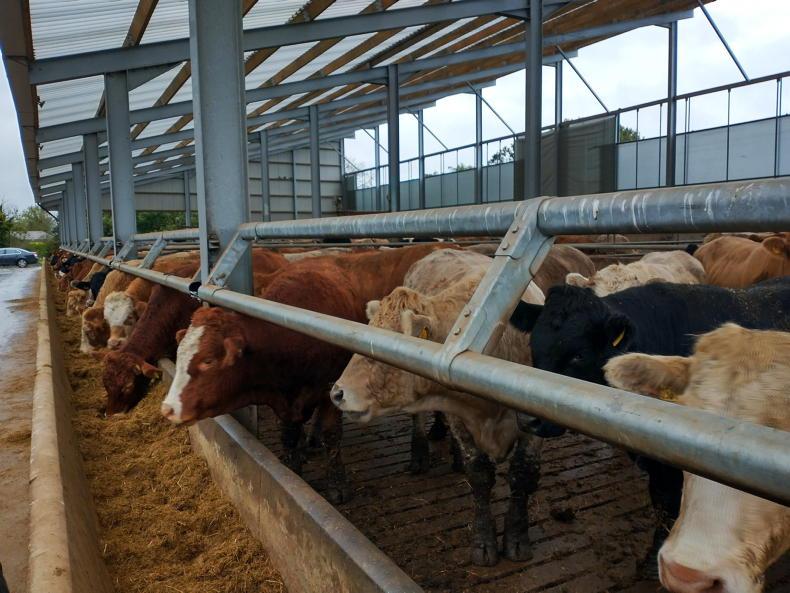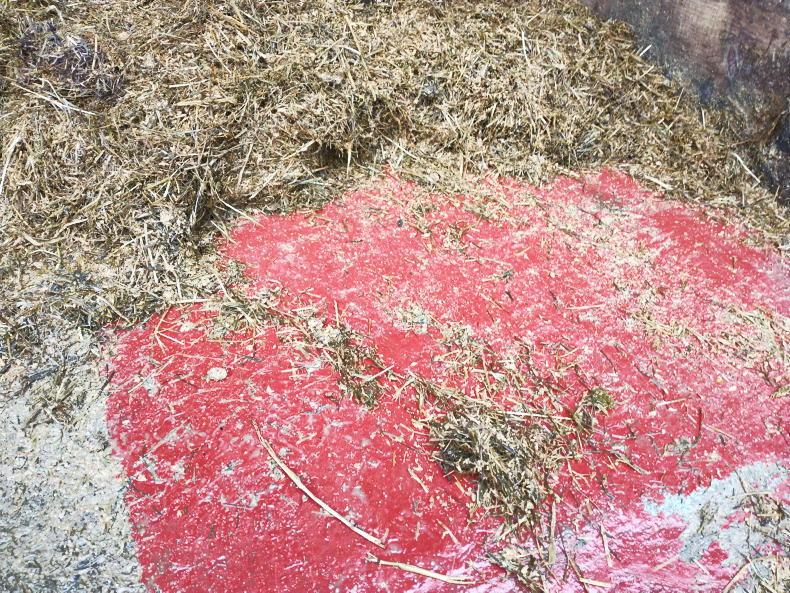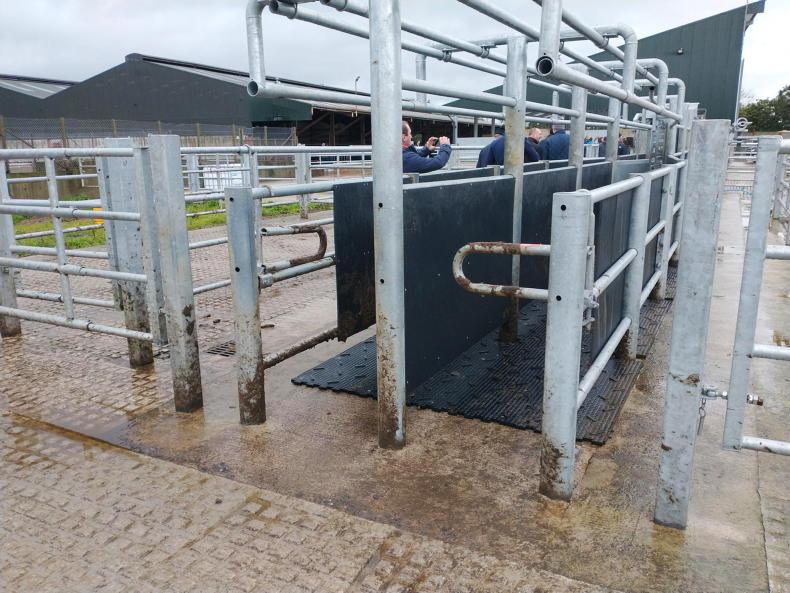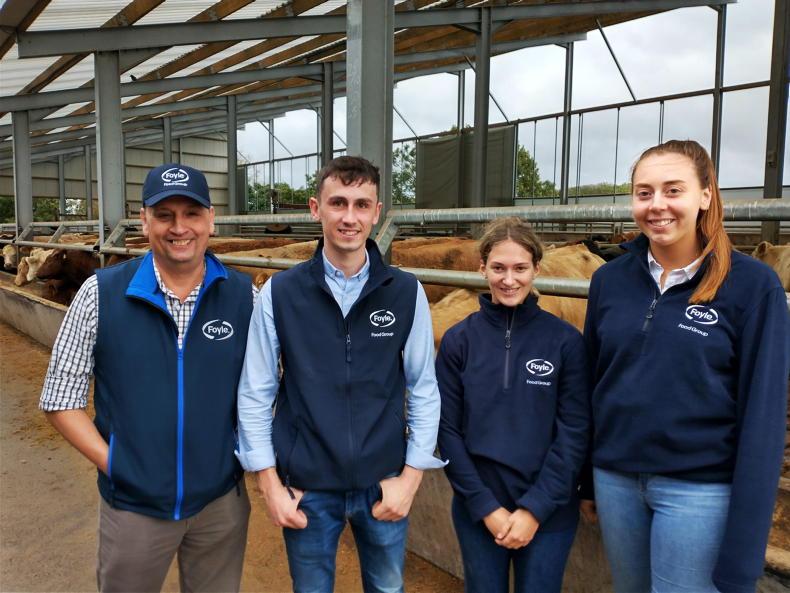Across approximately 1,000 head of cattle housed on the Foyle beef finishing unit outside Cookstown in Co Tyrone, average daily weight gains of 1.6kg to 1.7kg are being achieved.
Owned by Foyle Food Group director, Wayne Acheson, the finishing unit is part of the ‘Foyle Farms of Excellence’ programme, which also includes a 250ac lowland grazing farm and a separate 520ac hill farm. A further 250 acres is dedicated to silage-making.
The aim on all the farms is to demonstrate best practice while also undertaking various trials on technologies that improve efficiency and ultimately benefit both farmer suppliers and the environment.
As a business, Foyle has a 2030 target to reduce greenhouse gas emissions from its supply chain by 18%.

The new temperature controlled cattle house on the Foyle finishing unit.
“The environment-type measures we are focused on – they need to have a productivity win as well. We would not want to promote something that would cost you money,” Andrew Clarke from Foyle told farmer suppliers attending a recent autumn nutrition event.
The main focus on the finishing unit is to achieve high intakes of high-quality feed to drive liveweight gains and ensure a fast turnaround of cattle. The shorter the finishing period, the lower the emissions per kilo of beef.
The diet on the farm is formulated by Gareth Anderson from FarmGate Nutrition, with the total mixed ration (TMR) regularly tweaked depending on forage quality and availability of various straights.
Bought-in cattle are all steers. They are weighed on arrival and allocated to either a 30-, 60-, 90- or 120-day finishing period. Each animal is vaccinated against IBR and treated for worms and external parasites. Fluke treatment is also given, although the 30-day cattle are only treated during autumn and winter months. Once a group gets to 680kg they are sent to slaughter.
All cattle are transitioned on to the finishing diet, normally over a period of a couple of weeks, except for the 30-day cattle which will be offered 100% of requirements by day three. Cattle are given free access to chopped straw through this transition period.
DMI
Various research studies would suggest a finishing animal will eat 2% of its body weight in dry matter intake (DMI), so for a 620kg steer, maximum feed intake would be 12.4kg DM/day. However, the Foyle unit is achieving over 13kg in DMI.
“The higher the DMI the better the daily weight gains will be,” suggested Gareth. He said achieving high intakes is dependent on many factors.
“The cattle get fresh palatable feed on a regular basis. They are fed once per day, at the same time every day.”
He also emphasised the importance of not over-filling the diet feeder (to ensure a consistent mix) and keeping troughs clean, avoiding the buildup of waste which will heat and cause fresh feed to go off.
On the unit, the amount left is recorded before feeding and the volume offered tweaked accordingly. For example, if there are three consecutive days where zero is left, feed is increased by 1%.
“Access to water is essential. Cattle drink five to seven litres for every 1kg DMI so a 530kg bullock is drinking 55 to 77l per day. Cattle often drink together after feeding so you need to have capacity,” Gareth added.
High-welfare cattle handling system
A new handling unit was built on the Foyle finishing farm in 2022, with the design based on the ‘bud box’ system developed by legendary US cattleman, Bud Williams.
It is a relatively simple concept relying on the fact that the normal behaviour of cattle is to move away from humans and return to where they came from. Once into the main handling pen a sheeted gate is brought round to line up with the cattle race.
On the unit, a double race was installed with anti-jump rails and sheeted sides, which then merges into single file before cattle enter a Clipex HD2000 automated crush. The race is fitted with rubber flooring.
“There are 120 cattle coming on and moving off this farm every week. The handling system needs to be easy to manage and allow stock to run through,” explained Andrew Clarke.

In some of the older housing, an epoxy resin coating has been installed at the feed barrier to help improve intakes and make the surface easier to clean.
Temperature controlled cattle housing
In 2020, Foyle Food Group along with South West College in Omagh embarked on a project to develop and implement a high-welfare housing and bedding system for finishing cattle. The project was part funded by Innovate UK.
The end result is a new open-sided cattle house with a monopitch (slope in one direction) roof covered with polycarbonate sheeting. The house is orientated north to south with an 8m slatted area and 12m dry-bedded area.
The slurry tank runs under the entire house with small holes in the dry-bedded area to prevent a buildup of seepage.
A bubbler system has been fitted in the tank which means no mixing of slurry is required.
At the back of the shed an automatic curtain is linked to a weather station. When it is dry and the curtain is lowered, it helps to cut down on the amount of bedding required.
Across the Foyle finishing unit around half the cattle are on slats, with the other half on dry beds using either chopped straw or sawdust. Bedding costs in the last year come to around 30p (35c) per head per day.
The bedding is treated once per week with Actiferm, a product that contains bacteria, fungi and yeasts to help accelerate the fermentation process of animal manure.
When houses are cleaned out, the manure is left in a covered pile (anaerobic conditions) for eight weeks before spreading.
The process, known as ‘Bokashi’ composting, has been trialled on the Foyle unit since 2021.
Brushes
Other trial work includes looking at the effect of cattle brushes on behaviour, cleanliness and performance of finishing animals.
In work done between April and June 2022, a total of 72 steers were split into two groups, fed the same finishing diet over 60 days, but with one pen getting access to an AgriCow pendulum brush.

The cattle handling facility is based on 'bud box' design principles.
The results showed no benefit in terms of cleanliness. However, various measures of animal welfare were improved and daily liveweight gain increased by 0.21kg, which equates to an extra 12.86kg per head over the period.
The trial has since been repeated and produced similar results. A number of houses on the farm now include brushes and the plan is to install more.
Foyle farms of excellence
As well as a large beef finishing unit, the Foyle Farms of Excellence programme includes a hill farm and a lowland grazing farm.
On the hill farm, around 200 mainly Blue Grey and Angus sucklers are crossed to top 1% Angus bulls.
According to Andrew Clarke, the aim is to showcase a low input system, finishing cattle at 19 months at around 350kg carcase weight.
On the lowland grazing farm a paddock grazing system is in place, mainly based on perennial ryegrass, but with an increasing area of multispecies swards grown.
There is no wholecrop or maize grown on the Foyle farms, so grass silage forms the basis for the finishing diet with 13kg currently offered per head in the TMR.
First-cut quality is good with a dry matter of 29%, a protein of 13%, ME of 11.2MJ/kg DM, pH of 3.7 and a digestibility value of 70 (DMD 74.6).
Shown in Table 1 is the current feeding plan and in Table 2 the straights included in the home mix beef blend.
Overall, the TMR has a ME figure of 12.4MJ, a crude protein of 14% and a dry matter of 41%.
Principles
Explaining some of the main principles behind the make-up of the overall ration, Gareth Anderson said the likes of brewers grains and Northern Extra (both co-products from the brewing industry) are high in energy and protein and help drive intakes.
There is also 1.5kg of feed cane molasses, which Gareth maintains, helps to improve intakes and prevents sorting of the ration.
Finally, the 0.5kg of chopped hay is there to reduce incidences of acidosis – the alternative is 0.5kg of chopped straw.
In terms of the TMR on similar beef finishing units, Gareth said a number of clients are now using alkagrain and it is working “exceptionally well”.
Also biscuit meal is a “super product for starch and a highly palatable feed,” as is milled bread, although care needs to be taken to ensure it doesn’t go off, said Gareth.
He said potatoes “are hard to beat for starch,” but availability can be an issue, while fodder beet is high in sugar, although care needs to be taken to ensure it is clean when fed.
The home mix beef blend is mainly based on maize meal along with sugar beet nuts and maize distillers. A buffer is added to help prevent acidosis while GlycoPass meal is rumen protected glycerine which increases blood glucose levels. “It is a “product for the future,” suggested Gareth.
Alltech Rumenate is there to help improve rumen function, while Elensis 10 is a feed additive included to improve rumen efficiency.
The cost of the home mix blend comes to £312/t (€363/t).
The total cost of the TMR works out at £3.56 (€4.14) per head per day.
Opportunity to improve genetics
While the autumn event on the Foyle finishing unit mainly focused on nutrition and the results of various trials on finishing cattle, one of the main take-home messages for farmers was around the importance of animal genetics.
Since 1998, Foyle has worked with Aberdeen Angus Quality Beef (AAQB) Ltd to supply cattle to Tesco.
In recent years, Andrew Clarke maintains that many farmers have been overly focused on using Angus bulls that are easy calving and have short gestation, rather than good terminal characteristics. In 2019, Foyle purchased Elliot Bravo T452, an Angus bull in the top 1% for various terminal traits. Semen was made available to members of AAQB.
“With Bravo calves, we are seeing a consistent trend of less than 40 days to slaughter at the same average carcase weight. It is a 7% lift in performance just by using better genetics. The same principle applies to any breed,” said Andrew.
Second bull
In 2021, a second bull, Rawburn Enron W127 was made available to AAQB members by Foyle. As well as being in the top 1% of the breed for various terminal traits, Enron is ranked in the top 4% in the world for feed efficiency, requiring only 3.21kg of dry matter to produce 1kg of liveweight gain.
“It is important to ask for data on feed efficiency – we should put pressure on to get it going forward,” suggested Andrew.
Read more
Top genetics deliver in Angus scheme
Beef producer groups can add value for sector
Across approximately 1,000 head of cattle housed on the Foyle beef finishing unit outside Cookstown in Co Tyrone, average daily weight gains of 1.6kg to 1.7kg are being achieved.
Owned by Foyle Food Group director, Wayne Acheson, the finishing unit is part of the ‘Foyle Farms of Excellence’ programme, which also includes a 250ac lowland grazing farm and a separate 520ac hill farm. A further 250 acres is dedicated to silage-making.
The aim on all the farms is to demonstrate best practice while also undertaking various trials on technologies that improve efficiency and ultimately benefit both farmer suppliers and the environment.
As a business, Foyle has a 2030 target to reduce greenhouse gas emissions from its supply chain by 18%.

The new temperature controlled cattle house on the Foyle finishing unit.
“The environment-type measures we are focused on – they need to have a productivity win as well. We would not want to promote something that would cost you money,” Andrew Clarke from Foyle told farmer suppliers attending a recent autumn nutrition event.
The main focus on the finishing unit is to achieve high intakes of high-quality feed to drive liveweight gains and ensure a fast turnaround of cattle. The shorter the finishing period, the lower the emissions per kilo of beef.
The diet on the farm is formulated by Gareth Anderson from FarmGate Nutrition, with the total mixed ration (TMR) regularly tweaked depending on forage quality and availability of various straights.
Bought-in cattle are all steers. They are weighed on arrival and allocated to either a 30-, 60-, 90- or 120-day finishing period. Each animal is vaccinated against IBR and treated for worms and external parasites. Fluke treatment is also given, although the 30-day cattle are only treated during autumn and winter months. Once a group gets to 680kg they are sent to slaughter.
All cattle are transitioned on to the finishing diet, normally over a period of a couple of weeks, except for the 30-day cattle which will be offered 100% of requirements by day three. Cattle are given free access to chopped straw through this transition period.
DMI
Various research studies would suggest a finishing animal will eat 2% of its body weight in dry matter intake (DMI), so for a 620kg steer, maximum feed intake would be 12.4kg DM/day. However, the Foyle unit is achieving over 13kg in DMI.
“The higher the DMI the better the daily weight gains will be,” suggested Gareth. He said achieving high intakes is dependent on many factors.
“The cattle get fresh palatable feed on a regular basis. They are fed once per day, at the same time every day.”
He also emphasised the importance of not over-filling the diet feeder (to ensure a consistent mix) and keeping troughs clean, avoiding the buildup of waste which will heat and cause fresh feed to go off.
On the unit, the amount left is recorded before feeding and the volume offered tweaked accordingly. For example, if there are three consecutive days where zero is left, feed is increased by 1%.
“Access to water is essential. Cattle drink five to seven litres for every 1kg DMI so a 530kg bullock is drinking 55 to 77l per day. Cattle often drink together after feeding so you need to have capacity,” Gareth added.
High-welfare cattle handling system
A new handling unit was built on the Foyle finishing farm in 2022, with the design based on the ‘bud box’ system developed by legendary US cattleman, Bud Williams.
It is a relatively simple concept relying on the fact that the normal behaviour of cattle is to move away from humans and return to where they came from. Once into the main handling pen a sheeted gate is brought round to line up with the cattle race.
On the unit, a double race was installed with anti-jump rails and sheeted sides, which then merges into single file before cattle enter a Clipex HD2000 automated crush. The race is fitted with rubber flooring.
“There are 120 cattle coming on and moving off this farm every week. The handling system needs to be easy to manage and allow stock to run through,” explained Andrew Clarke.

In some of the older housing, an epoxy resin coating has been installed at the feed barrier to help improve intakes and make the surface easier to clean.
Temperature controlled cattle housing
In 2020, Foyle Food Group along with South West College in Omagh embarked on a project to develop and implement a high-welfare housing and bedding system for finishing cattle. The project was part funded by Innovate UK.
The end result is a new open-sided cattle house with a monopitch (slope in one direction) roof covered with polycarbonate sheeting. The house is orientated north to south with an 8m slatted area and 12m dry-bedded area.
The slurry tank runs under the entire house with small holes in the dry-bedded area to prevent a buildup of seepage.
A bubbler system has been fitted in the tank which means no mixing of slurry is required.
At the back of the shed an automatic curtain is linked to a weather station. When it is dry and the curtain is lowered, it helps to cut down on the amount of bedding required.
Across the Foyle finishing unit around half the cattle are on slats, with the other half on dry beds using either chopped straw or sawdust. Bedding costs in the last year come to around 30p (35c) per head per day.
The bedding is treated once per week with Actiferm, a product that contains bacteria, fungi and yeasts to help accelerate the fermentation process of animal manure.
When houses are cleaned out, the manure is left in a covered pile (anaerobic conditions) for eight weeks before spreading.
The process, known as ‘Bokashi’ composting, has been trialled on the Foyle unit since 2021.
Brushes
Other trial work includes looking at the effect of cattle brushes on behaviour, cleanliness and performance of finishing animals.
In work done between April and June 2022, a total of 72 steers were split into two groups, fed the same finishing diet over 60 days, but with one pen getting access to an AgriCow pendulum brush.

The cattle handling facility is based on 'bud box' design principles.
The results showed no benefit in terms of cleanliness. However, various measures of animal welfare were improved and daily liveweight gain increased by 0.21kg, which equates to an extra 12.86kg per head over the period.
The trial has since been repeated and produced similar results. A number of houses on the farm now include brushes and the plan is to install more.
Foyle farms of excellence
As well as a large beef finishing unit, the Foyle Farms of Excellence programme includes a hill farm and a lowland grazing farm.
On the hill farm, around 200 mainly Blue Grey and Angus sucklers are crossed to top 1% Angus bulls.
According to Andrew Clarke, the aim is to showcase a low input system, finishing cattle at 19 months at around 350kg carcase weight.
On the lowland grazing farm a paddock grazing system is in place, mainly based on perennial ryegrass, but with an increasing area of multispecies swards grown.
There is no wholecrop or maize grown on the Foyle farms, so grass silage forms the basis for the finishing diet with 13kg currently offered per head in the TMR.
First-cut quality is good with a dry matter of 29%, a protein of 13%, ME of 11.2MJ/kg DM, pH of 3.7 and a digestibility value of 70 (DMD 74.6).
Shown in Table 1 is the current feeding plan and in Table 2 the straights included in the home mix beef blend.
Overall, the TMR has a ME figure of 12.4MJ, a crude protein of 14% and a dry matter of 41%.
Principles
Explaining some of the main principles behind the make-up of the overall ration, Gareth Anderson said the likes of brewers grains and Northern Extra (both co-products from the brewing industry) are high in energy and protein and help drive intakes.
There is also 1.5kg of feed cane molasses, which Gareth maintains, helps to improve intakes and prevents sorting of the ration.
Finally, the 0.5kg of chopped hay is there to reduce incidences of acidosis – the alternative is 0.5kg of chopped straw.
In terms of the TMR on similar beef finishing units, Gareth said a number of clients are now using alkagrain and it is working “exceptionally well”.
Also biscuit meal is a “super product for starch and a highly palatable feed,” as is milled bread, although care needs to be taken to ensure it doesn’t go off, said Gareth.
He said potatoes “are hard to beat for starch,” but availability can be an issue, while fodder beet is high in sugar, although care needs to be taken to ensure it is clean when fed.
The home mix beef blend is mainly based on maize meal along with sugar beet nuts and maize distillers. A buffer is added to help prevent acidosis while GlycoPass meal is rumen protected glycerine which increases blood glucose levels. “It is a “product for the future,” suggested Gareth.
Alltech Rumenate is there to help improve rumen function, while Elensis 10 is a feed additive included to improve rumen efficiency.
The cost of the home mix blend comes to £312/t (€363/t).
The total cost of the TMR works out at £3.56 (€4.14) per head per day.
Opportunity to improve genetics
While the autumn event on the Foyle finishing unit mainly focused on nutrition and the results of various trials on finishing cattle, one of the main take-home messages for farmers was around the importance of animal genetics.
Since 1998, Foyle has worked with Aberdeen Angus Quality Beef (AAQB) Ltd to supply cattle to Tesco.
In recent years, Andrew Clarke maintains that many farmers have been overly focused on using Angus bulls that are easy calving and have short gestation, rather than good terminal characteristics. In 2019, Foyle purchased Elliot Bravo T452, an Angus bull in the top 1% for various terminal traits. Semen was made available to members of AAQB.
“With Bravo calves, we are seeing a consistent trend of less than 40 days to slaughter at the same average carcase weight. It is a 7% lift in performance just by using better genetics. The same principle applies to any breed,” said Andrew.
Second bull
In 2021, a second bull, Rawburn Enron W127 was made available to AAQB members by Foyle. As well as being in the top 1% of the breed for various terminal traits, Enron is ranked in the top 4% in the world for feed efficiency, requiring only 3.21kg of dry matter to produce 1kg of liveweight gain.
“It is important to ask for data on feed efficiency – we should put pressure on to get it going forward,” suggested Andrew.
Read more
Top genetics deliver in Angus scheme
Beef producer groups can add value for sector









 This is a subscriber-only article
This is a subscriber-only article











SHARING OPTIONS: